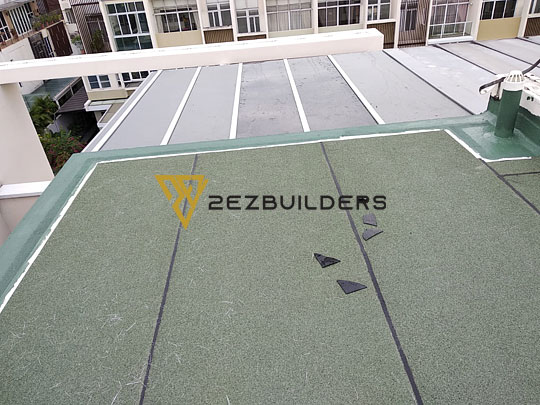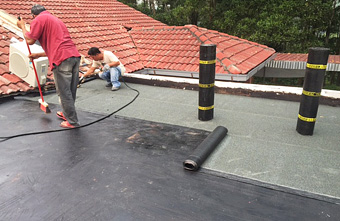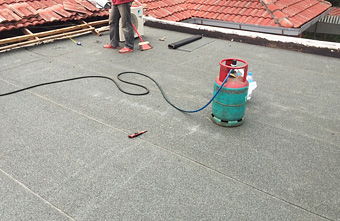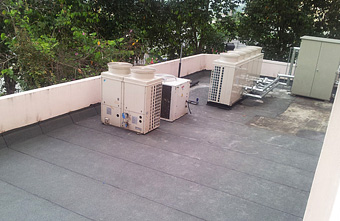Home » Waterproofing » Waterproofing Membrane
Waterproofing Membrane
Our waterproofing solutions make use of a full range of high-performance liquid applied and torch on membranes which offer both durability and elasticity. These waterproofing membranes offer a number of benefits, including its flexibility on taking any shape it is laid over and has a long life span due to its tightness of membrane against the surface.
What is Waterproofing Membrane
A waterproofing membrane is a thin layer of water-tight material that is laid over a surface. This layer is continuous and does not allow water to pass through it. For example, on a flat terrace, a waterproofing membrane could be laid above the structural slab and below the finish tiles. This will ensure that water does not seep into the structural slab. The tiles and membrane must be laid over a filler material that is sloped to ensure that water flows into sumps and drains. Any water that remains as puddles over the tiles is likely to seep into the slab over time, so puddles are to be avoided at all costs.
These membranes are composed of thin layers of waterproof material. Most are about 2 to 4mm thick. There are essentially 2 types of membranes, torch on membranes and liquid applied membranes.
Ideally, a waterproofing membrane should be strong, flexible, tear-resistant and elastic so that it can stretch to cover cracks and also move with the building. If the membrane is to be exposed to the sun, then it should be UV stable. The membrane should be flexible enough to take any shape it is laid over, and be capable of turning up and over walls and other construction features.
Liquid Applied and Torch On Membranes
Waterproofing Membranes, both the liquid applied and torch on, are required on projects that also need waterproofing. However, torch on membranes are generally used when a more durable option is required. Liquid applied membranes have been specialised in waterproofing to allow waterproofing to become more efficient and convenient.
They are applied by flame bonding, allowing application to have a uniform thickness, stability at extreme temperatures, a high impact resistance, and high elasticity which can be later painted over to be maintaining colour consistency.
What areas of a structure often require membranes?
As torch on membranes often need to be more durable than liquid applied ones, the below areas are the most commonly applied:
Concrete Roofs
As concrete is a thick hardening product, torch on membranes support the waterproofing longevity of concrete.
Basements
Basements are prone to water ingress, so a torch on membrane offers stronger waterproofing.
Foundations and Tunnels
Foundations need to be sturdy and therefore require the durability torch on membranes offer. Due to tunnels frequent use, sturdy torch on membranes are applied.
Waterproofing Membrane can also be used in the following parts of a building:
- Terrace slabs and balconies
- Toilets
- Underneath and around basements
- Concrete water tanks
- Swimming pools
- Landscaped concrete decks, between the soil and concrete
- Gutters
We have many years of experience in the remedial repair industry and specialise in the application of both liquid applied and torch on membranes. Our technique to apply these membranes is listed below.
Liquid Applied Membrane
- Prepare surface
- Apply product to Dry Film Thickness
- Embed bandage/fleece (if applicable)
- Repeat costs of product as per specifications.
Torch On Membrane
- Prepare surface
- Roll out sheets
- Apply the necessary heat source
- Repeat the sheets as per specifications.
Liquid Applied Waterproofing Membrane
Liquid applied waterproofing membranes come to the site in liquid form, which are then either sprayed or brush-applied on the surface. The liquid cures in the air to form a seamless, joint-free membrane. The thickness can be controlled by applying more of the liquid chemical per unit area.
Since the application procedure is very quick, we will try and finish the entire area to be waterproofed in a single day to avoid cold joints. However, if a very large area is to be done on successive days, cold joints can easily be done by overlapping the new membrane over the old – the chemical will stick to itself readily.
These are generally considered to be superior to torch on membranes as they are joint-free. However care must be taken in application to provide just the right thickness. The membrane can tear or break if it is too thin. The adhesion of the membrane to concrete must be good.
If a concrete screed (layer) is to be applied over a waterproofing membrane, the membrane is made rough by sand broadcasting. This is throwing a thin layer of sand by hand over the wet membrane (before it has set fully) so that the sand sticks to the membrane and provides a rough surface the concrete can adhere to.
Torch On Waterproofing Membrane
These membranes arrive at the site in the form of rolls. These are then unfurled and laid on a firm surface. The most common type of torch on membrane is a bituminous waterproofing membrane. This type of membrane is stuck to the substrate with a hot tar based adhesive using blowtorches.
Joints between adjacent membranes are also made with the same hot adhesive. The sheets are overlapped by about 100mm (4″) to form a waterproof joint. Some membranes are even joined by melting them with a hot air gun and then overlapping them on the previously laid sheet.
With this type of membrane, joints between sheets are critical, and must be done perfectly to avoid leakage.
Other types of sheet torch on membranes are PVC membranes and composite membranes. The latter have a fabric base that provides strength and tear resistance, and a chemical that coats the fabric to provide resistance.
Since these membranes are factory-produced excepting the joints, they are consistent in quality.
How to select a Waterproofing Membrane
Check for the following properties of the membrane:
UV Stability
If the membrane is to be exposed to the sun, than it must be UV stable or UV resistant, else it will degrade over time.
Elongation
This is the ability of the membrane to stretch. It is measured in percentages. An elongation of 150% means that the membrane can stretch to 1.5 times its length when pulled. Elongation is a must in buildings that will move, such as high-rise buildings, or buildings made with steel, which is flexible. This property will allow the membrane to stretch over cracks that may develop in the future. Membranes with elongation properties of over 200% are available.
Breathability
One disadvantage of good waterproofing is that if water does happen to enter into the structure from a point and spread across a surface, that water is trapped inside the structure, and cannot get out. Breathable membranes help to release that water to the air in the form of water vapor. So some membranes are designed to prevent water from passing through them, while at the same time allowing water vapor to pass through. So over time, breathable membranes allow trapped water to evaporate into the atmosphere.
Tear Resistance
This is an important property, as many membranes that have good elongation also can tear easily. Take a small sample of the material in your hand, and try and tear it into two pieces. This gives a fair idea of its tear resistance. You are looking for a membrane that will not tear even if a reasonable force is exerted on it.
Abrasion Resistance
This is the ability of a membrane to withstand wear and tear. As most membranes are covered concrete screeds and tiling, the abrasion resistance comes into play during the construction period, when workers are walking on the surface, dropping nails and screws, and scraping hard objects like rebar against the membrane, which can damage it. A very soft membrane with low abrasion resistance may get damaged in such a situation, which can cause it to leak.
Chemical stability
Check that the membrane is chemically inert with respect to its environment in the building. Some membranes, especially outside basement walls, are exposed to the soil and rainwater outside.
Food Safety
Membranes can be applied to the inside of concrete water tanks to make them waterproof. In this case, the membrane must be food safe, as the water is in contact with the membrane.
Geometry
If a membrane has to be installed over a complicated shape, such as the junction of a column and beam, then a liquid applied membrane is preferable, as it can be applied to any type of underlying shape or structure. A sheet membrane would form folds and creases and leave gaps between the underlay and membrane.
We have highly qualified waterproofing specialists available who can assess the scope of damage and then recommend the required membrane that will need to be applied post waterproofing. Contact us today for more information.
What Our Customers Saying
Waterproofing Specialist
We offer waterproofing services for all aspects of residential, commercial and industrial constructions. We can carry out surface waterproofing treatments, concrete sealing, concrete jointing and leak sealing, our team of experienced waterproofing contractors can help solve all waterproofing issues that you may have in a fast, efficient and cost effective manner.
In addition to waterproofing solutions for new construction projects, we have many years of experience in remediation work to fix old moisture leak problems. This occurs when waterproofing membranes have not been installed correctly or were installed against the manufacturers specifications.
We can repair leaking roofs, timber / steel / concrete balconies, water features and even swimming pools. With a large range of quality products and services in our tool belt, 2ezBuilders will have the solution to your waterproofing problem.







 9119 4422
9119 4422